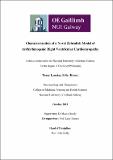| dc.contributor.advisor | Grealy, Maura | |
| dc.contributor.advisor | Byrnes, Lucy | |
| dc.contributor.author | Lynskey, Tracy | |
| dc.date.accessioned | 2018-12-17T09:54:50Z | |
| dc.date.issued | 2018-12-14 | |
| dc.identifier.uri | http://hdl.handle.net/10379/14711 | |
| dc.description.abstract | Arrhythmogenic Right Ventricular Cardiomyopathy (ARVC) is a congenital heart disorder characterized by replacement of the ventricular myocardium with fibrofatty tissue. The majority of cases are due to mutations in genes encoding desmosomal cell junction proteins, including plakophilin-2 and plakoglobin. Naxos disease is an autosomal recessive form of ARVC that is caused by a 2 bp C-terminal deletion in the desmosomal plakoglobin (JUP) gene, resulting in the expression of a truncated plakoglobin protein. This causes skin abnormalities from infancy as well as heart defects that develop in early adulthood. The pathogenesis of ARVC/Naxos Disease is poorly understood and current animal models do not fully recapitulate the human disease. My project aimed to characterize a novel zebrafish model of ARVC. I first attempted to knock out the plakophilin-2 gene in zebrafish using TALEN and CRISPR genome editing technology. As this approach was unsuccessful I continued with sa12692 plakoglobin mutants. Similar to ARVC patients, sa12692 mutants develop to adulthood with similar survival rates to WT controls. 3’RACE and western blot revealed that the sa12692 plakoglobin mutation causes exon 14 to be skipped, leading to reduced expression of a truncated protein, highly similar to Naxos plakoglobin protein in humans. Whole transcriptome profiling identified 1,072 differentially expressed genes in mutant adult hearts, including several involved in cardiac function. An ingenuity pathway analysis revealed adherens junction signalling and remodelling of adherens junction signalling as the top significantly enriched pathways, supporting the role of altered junctional components in the development of ARVC. Other adhesion-related signalling pathways were also altered including integrin, paxillin and integrin-linked kinase signalling pathways. In addition, the sirtuin signalling pathway, linked to mitochondrial function was altered providing novel insights into ARVC pathogenesis. Markers of ARVC including arrhythmia, fibrosis, apoptosis and cardiac dilation were identified by a toxicity function analysis. Intercalated disc remodelling has been frequently observed in ARVC human hearts. Therefore, the ultrastructure of heart and skin at larval and adult stages was examined by transmission electron microscopy and junctions were quantified by stereology. Desmosomes and adherens junctions were significantly reduced in both larval and adult mutant skin, with significantly increased intercellular gaps. While desmosome number was reduced in the mutant larval hearts, junction number in the adult hearts was normal. However, widened intercellular gaps indicate only a partial compensation of intercalated disc function. Alterations in junctional components are indicative of abnormal cell adhesion and support the RNA-seq findings. Overall, I have established an authentic model of ARVC that recapitulates several aspects of the human disease and provides novel insights into the molecular mechanisms underlying the disease pathogenesis. | en_IE |
| dc.publisher | NUI Galway | |
| dc.rights | Attribution-NonCommercial-NoDerivs 3.0 Ireland | |
| dc.rights.uri | https://creativecommons.org/licenses/by-nc-nd/3.0/ie/ | |
| dc.subject | Zebrafish | en_IE |
| dc.subject | Desmosomes | en_IE |
| dc.subject | Arrhythmia | en_IE |
| dc.subject | Cardiomyopathy | en_IE |
| dc.subject | Plakoglobin | en_IE |
| dc.subject | TEM | en_IE |
| dc.subject | ARVC | en_IE |
| dc.subject | RNA-seq | en_IE |
| dc.subject | Naxos | en_IE |
| dc.subject | Medicine | en_IE |
| dc.subject | Pharmacology and Therapeutics | en_IE |
| dc.title | Characterization of a novel zebrafish model of arrhythmogenic right ventricular cardiomyopathy | en_IE |
| dc.type | Thesis | en |
| dc.contributor.funder | Irish Research Council | en_IE |
| dc.contributor.funder | Health Research Board | en_IE |
| dc.contributor.funder | College of Medicine, Nursing and Health Sciences, NUI Galway | en_IE |
| dc.local.note | Arrhythmogenic right ventricular cardiomyopathy (ARVC) causes sudden cardiac death. The Naxos disease form also causes skin defects, due to a plakoglobin mutation. This work characterizes a novel zebrafish plakoglobin mutant. It has cell adhesion defects in the heart and skin, and altered cellular signalling pathways, providing a new disease model. | en_IE |
| dc.description.embargo | 2022-12-12 | |
| dc.local.final | Yes | en_IE |
| nui.item.downloads | 115 | |


